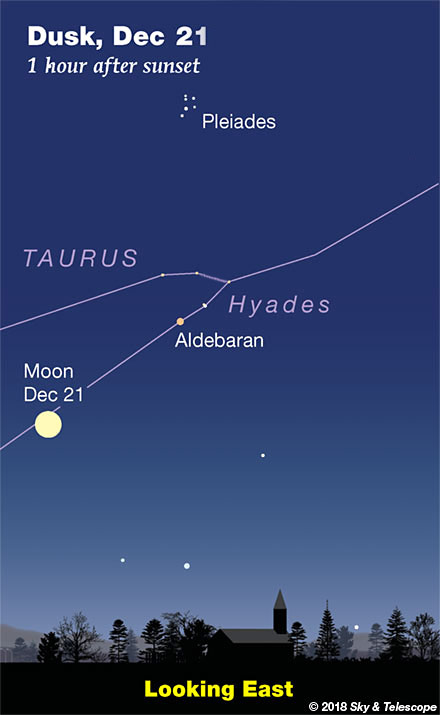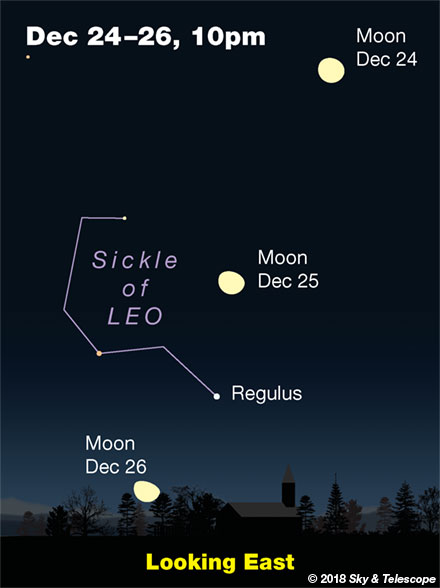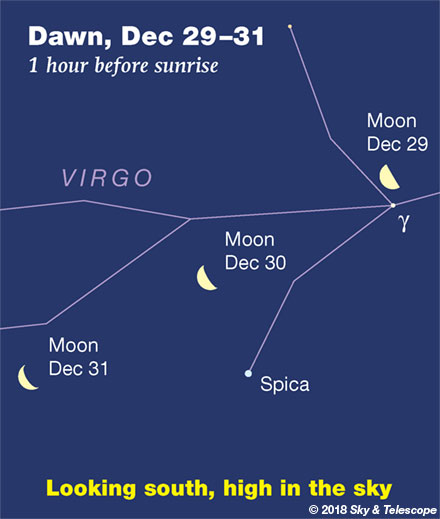


Friday, December 21
• By mid-evening the Moon, nearly full, forms a tall triangle with Aldebaran to its upper right (shown here) and Betelgeuse to its lower right (not yet risen in this twilight scene). Aldebaran is an orange, K5 giant star 65 light-years away. Betelgeuse is an orange, slightly less hot M1 supergiant about 10 times more distant.
• This is the longest night of the year for the Northern Hemisphere; the longest day for the Southern Hemisphere. The solstice occurs at 5:23 p.m. EST, when the Sun reaches its farthest point south and begins its six-month return northward. Winter begins in the Northern Hemisphere, summer in the Southern.
Saturday, December 22
• Full Moon (exact at 12:49 p.m. EST). The Moon, near perigee, shines between the feet of the Castor figure and the dim Club of Orion.
Farther left or lower left of the Moon are brighter Castor and Pollux. Farther right or lower right of the Moon is Orion, with his belt almost vertical.
The full Moon of December rides higher across the sky in the middle of the night than it does in any other month (for Northern Hemisphere skywatchers), "giving luster of midday to objects below."
• Algol should be at minimum brightness for a couple hours centered on 11:36 p.m. EST. Algol takes several additional hours to fade and to rebrighten.
Sunday, December 23
• As the stars come out, face due north and look high. Cassiopeia is now a flattened M shape canted at about a 45° angle (depending on where you live). Yet hardly more than an hour later, the M has turned horizontal. Why so fast? Constellations passing near the zenith appear to rotate rapidly with respect to the direction "up."
Monday, December 24
• This is the time of year when Orion shines in the east-southeast after dinnertime. He's pretty high now, but his three-star Belt is still nearly vertical.
The Belt points up toward Aldebaran and, even higher, the Pleiades. In the other direction, it points down to where bright Sirius will rise around 7 or 8 p.m. to twinkle furiously.
Tuesday, December 25
• Sirius and Procyon in the balance: Sirius, the Dog Star, sparkles low in the east-southeast by mid-evening. Procyon, the Little Dog Star, shines in the east about two fist-widths at arm's length to Sirius's left. If you live around latitude 30° (Tijuana, New Orleans, Jacksonville), these two canine stars will be at the same height above your horizon soon after they rise. If you're north of that latitude, Procyon will be higher. If you're south of there, Sirius will be the higher one.
Why? The eastern edge of the Earth tilts differently with respect to the stars depending on your latitude.
• You'll catch Algol at its minimum brightness for a couple hours centered on 8:26 p.m. EST.
Wednesday, December 26
• The Pleiades cluster glitters high in the southeast these evenings, no bigger than your fingertip at arm's length. How many Pleiads can you count with your unaided eyes? Take your time and keep looking. Most people can count 6. With sharp eyesight, a good dark sky, and a steady gaze, you may be able to make out 8 or 9.
Thursday, December 27
• M31, the Andromeda Galaxy, now crosses the zenith shortly after dark (if you live in the mid-northern latitudes). Exactly when? That depends on your longitude. Binoculars will show it just off the knee of the Andromeda constellation's stick figure; see the big evening constellation chart in the center of Sky & Telescope.
Friday, December 28
• Last-quarter Moon tonight (exact at 4:39 a.m. on the 29th EST). The Moon, half-lit, rises around midnight in Virgo. By the beginning of Saturday's dawn it's shining high in the south, close above Gamma (γ) Virginis and about a fist and a half upper right of Spica (as shown above).
Saturday, December 29
• Before dawn on Sunday the 30th, the waning Moon shines upper left of Spica. Much farther upper left of the Moon is Arcturus, pale yellow-orange.
Far to the Moon's lower left are bright Venus, then Jupiter, then Mercury.
________________________
Want to become a better astronomer? Learn your way around the constellations! They're the key to locating everything fainter and deeper to hunt with binoculars or a telescope.
This is an outdoor nature hobby. For an easy-to-use constellation guide covering the whole evening sky, use the big monthly map in the center of each issue of Sky & Telescope, the essential guide to astronomy.

Once you get a telescope, to put it to good use you'll need a detailed, large-scale sky atlas (set of charts). The basic standard is the Pocket Sky Atlas (in either the original or Jumbo Edition), which shows stars to magnitude 7.6.
Next up is the larger and deeper Sky Atlas 2000.0, plotting stars to magnitude 8.5; nearly three times as many. The next up, once you know your way around, are the even larger Interstellarum atlas (stars to magnitude 9.5) and Uranometria 2000.0 (stars to magnitude 9.75). And read how to use sky charts with a telescope.
You'll also want a good deep-sky guidebook, such as Sue French's Deep-Sky Wonders collection (which includes its own charts), Sky Atlas 2000.0 Companion by Strong and Sinnott, or the bigger Night Sky Observer's Guide by Kepple and Sanner.
Can a computerized telescope replace charts? Not for beginners, I don't think, and not on mounts and tripods that are less than top-quality mechanically (meaning heavy and expensive). And as Terence Dickinson and Alan Dyer say in their Backyard Astronomer's Guide, "A full appreciation of the universe cannot come without developing the skills to find things in the sky and understanding how the sky works. This knowledge comes only by spending time under the stars with star maps in hand."
This Week's Planet Roundup
Mercury (magnitude –0.4) and brighter Jupiter (mag. –1.8) are together low in the dawn this week. Look for them above the southeast horizon, about 25° lower left of Venus, 45 minutes or so before sunrise. Jupiter and Mercury appear closest together (about 1° apart) on the mornings of December 21st and 22nd. Each morning after that Jupiter climbs farther to the upper right and Mercury sinks lower.
Venus (magnitude –4.7, in Virgo) rises as an eerie "UFO" above the east-southeast horizon more than two hours before the first light of dawn. As dawn arrives, Venus is the brilliant "Morning Star" dominating the southeast. In a telescope Venus is a very thick crescent, waxing from 41% to 45% sunlit this week.
Mars (magnitude +0.3 in Pisces, under the Great Square of Pegasus) shines highest in late twilight and sets by 11 or midnight. In a telescope it's gibbous and quite small, 8 arcseconds from pole to pole.
Saturn is lost in the sunset.
Uranus (magnitude 5.7, at the Aries-Pisces border) is highest in the south right after dark. It's visible in binoculars is you have a good finder chart and if you know the constellations well enough to see where to start with the chart.
Neptune, in Aquarius, is lower in the southwest right after dark and quite a bit more difficult at magnitude 7.9. Finder charts.
______________________
All descriptions that relate to your horizon — including the words up, down, right, and left — are written for the world's mid-northern latitudes. Descriptions that also depend on longitude (mainly Moon positions) are for North America.
Eastern Standard Time (EST) is Universal Time (UT or GMT) minus 5 hours.
______________________
"Science is built up of facts, as a house is with stones. But a collection of facts is no more a science than a heap of stones is a house."
— Henri Poincaré (1854–1912)
______________________
 4
4








Comments
Rod
December 21, 2018 at 9:53 pm
The rain moved out earlier and now some altocumulus and cumulus clouds in the area. Light ground fog forming over the fields and woods. I was able to get out from 2030-2115 EST and enjoy a view of the nearly Full Moon. I used my 90-mm refractor with 32-mm plossl eyepiece and moon filter (needed it tonight). Enjoyed viewing Tycho crater and rays, Kepler crater with rays, Copernicus crater with rays, Aristarchus crater bright, Menelaus crater with ejecta on Mare Serenitatis. Very good views using the Moon filter. Moon 99.4% illuminated. At 2108 EST the Moon is 54 degrees altitude and 112 degrees azimuth at my location in Taurus.
You must be logged in to post a comment.
mary beth
December 24, 2018 at 11:08 pm
Merry Christmas to all! Rod, did you see Santa Claus in your telescope? I think as of this post9ng, he is in a Portland ME per NORAD.....should be coming your way soon!
You must be logged in to post a comment.
Rod
December 24, 2018 at 11:19 pm
mary beth, no. I did not see Santa in my 90-mm, 10-inch or 10x50 binoculars. However, my wood burning stove is running now. Santa coming down my chimney will have quite a surprise, ho, ho, ho, Rudolf! get me out of here! 🙂
You must be logged in to post a comment.
Rod
December 27, 2018 at 10:58 am
Early this morning near 0600 EST, I enjoyed some telescope views of Venus in Libra, clear morning sky and temps near -4C. Some notes from my log [Enjoyed viewing Venus at 78x this morning with Moon filter. Some cloud bands visible near terminator and equator near terminator line (cloud shading). Good views of the waning gibbous Moon in Leo. Theophilus crater interesting view and many craters in south region along terminator. While viewing Venus at 78x, I removed the Moon filter and enjoyed some views of Zubenelgenubi or Alpha Librae double star in Libra. Very good and large split. Both stars very distinct.] Venus is moving eastward passing Zubenelgenubi double star now but on 29-May-18, Jupiter was retrograding one degree from the double star in Libra. I enjoyed telescope views of Jupiter, 4 Galilean moons and the double star in the same field of view then. This year, Venus and Jupiter moved past the same double star system in Libra but in opposite directions! Heliocentric solar system astronomy is great fun folks.
You must be logged in to post a comment.
You must be logged in to post a comment.